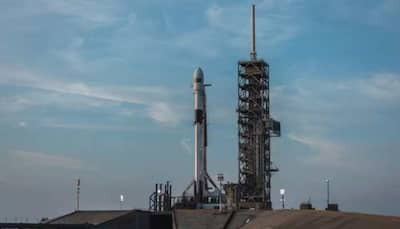After 41 long years since Rakesh Sharma made his historic journey to space, India is finally returning to the cosmos. This time, it’s Group Captain Shubhanshu Shukla from the Indian Air Force who will pilot the Axiom Mission 4 (Ax-4) to the International Space Station on June 10, 2025. But behind this momentous achievement lies an engineering marvel that has revolutionised space travel – the SpaceX Falcon 9 human-rated launch vehicle.
The Falcon 9 Block 5 isn’t just another rocket; it’s the world’s most reliable launch vehicle today. As of 04 June 2025, Falcon 9 had achieved 482 out of 485 full mission successes (99.4%), with Block 5 has a success rate of 99.8% (428/429). To put this in perspective, when you book a flight ticket, you don’t worry about the plane crashing because commercial aviation has a 99.99% safety record. The Falcon 9 is now approaching similar levels of reliability for space travel.
What makes this even more remarkable is that The Crew Dragon, including the Falcon 9 rocket and associated ground systems, is the first new, crew spacecraft to be NASA-certified for regular flights with astronauts since the space shuttle nearly 40 years ago. When NASA gives its human-rating certification, it means the rocket has passed the most stringent safety tests possible.
For Axiom 4, the choice of Falcon 9 Block 5 isn’t just practical – it’s essential. Shubhanshu Shukla, an Indian Air Force (IAF) pilot and astronaut with the Indian Space Research Organisation (ISRO) will be the pilot onboard the SpaceX Crew Dragon, making him the first Indian to visit the ISS. The stakes couldn’t be higher.
The Ax-4 research complement includes around 60 scientific studies and activities representing 31 countries, including the U.S., India, Poland, Hungary, Saudi Arabia, Brazil, Nigeria, UAE, and nations across Europe. This isn’t just any space mission – it’s the most ambitious research mission in Axiom Space’s history, and it needs a rocket system that won’t let down 31 countries worth of scientific hopes.
The Falcon 9’s reusability factor is also crucial. As of 04 June 2025, SpaceX has successfully landed Falcon 9 boosters 441 times. Individual boosters have flown as many as 28 flights. This proven track record of landing and reusing boosters means the rocket launching Axiom 4 has likely been tested multiple times before, adding another layer of reliability.
For India, this mission represents much more than just sending one astronaut to space. Shukla is honored and excited as he prepares to pilot the historic Axiom Mission 4 (Ax-4) to the International Space Station (ISS), leaving an indelible mark on India’s remarkable advancements in human space exploration.
The timing is perfect. ISRO has officially declared 2025 as the ‘Year of Gaganyaan’, making Shukla’s mission timely and critical. Shukla’s experience aboard the ISS will directly benefit India’s own Gaganyaan program, giving ISRO invaluable first-hand data about human spaceflight operations.
What’s particularly exciting is the research component. Shukla will carry out seven experiments designed by Indian institutions. These include studies on microgravity plant growth involving crops like methi (fenugreek) and moong (green gram). Imagine the possibilities – if we can grow Indian crops in space, it opens up entirely new frontiers for food security and space colonisation.
The human-rating of Falcon 9 represents a safety revolution in spaceflight. NASA’s human-rating requires not just that a system be designed to be tolerant of failure and to protect the crew even if an unrecoverable failure occurs, but also that astronauts aboard a human-rated spacecraft have some control over it. More importantly, the NASA CCP human-rating standards require that the probability of a loss on ascent does not exceed 1 in 500, and that the probability of a loss on descent did not exceed 1 in 500.
F9 has triple-redundant flight computers and inertial navigation, with a GPS overlay for additional accuracy. SpaceX uses multiple redundant flight computers in a fault-tolerant design. The software runs on Linux and is written in C++. This means if one computer fails, two others can still safely control the rocket.
The crown jewel of crew safety is Dragon’s integrated escape system. For launch aborts, the capsule relies on eight SuperDraco engines arranged in four redundant pairs. Each engine generates 71 kN (16,000 lbf) of thrust. A redundant array of eight SuperDraco engines provides fault-tolerant propulsion for use as a launch escape system. During the January 2020 abort test, the abort system propelled a Crew Dragon capsule to a distance of half a mile in 7.5 seconds, accelerating the craft to 400 mph relative to the booster.
Dragon 2 uses a total of six parachutes (two drogues and four mains) to decelerate after atmospheric entry and before splashdown, compared to the five used by Dragon 1. The additional parachute was required by NASA as a safety measure. The spacecraft can safely splash down with just three main chutes and possibly two.
In 2024, SpaceX added an incredible backup capability. Dragon now has built-in redundancy to propulsively land using its SuperDraco thrusters, saving the vehicle and potential crew from a rough landing or imminent danger. Should an anomaly with the parachutes occur, the four main parachutes would be cut and Dragon would ignite its eight SuperDraco engines to slowly perform a propulsive splashdown.
This is the final step in the multi-mission certification process, which included a number of previous launches, including an uncrewed ISS docking mission, which ran fully automated, and a launch pad abort test to demonstrate how the launch vehicle’s safety system would work in the unlikely event of an accident following launch but prior to reaching orbit.
: The Falcon 9’s nine-engine first stage design provides incredible redundancy. The nine Merlin engines on the first stage are gradually throttled near the end of first-stage flight to limit launch vehicle acceleration as the rocket’s mass decreases with the burning of fuel. Even if one engine fails during flight, the mission can continue successfully – this was proven during Flight 83, a successful Starlink launch that saw the first failure of a Merlin 1D first-stage engine during ascent.
When the capsule returns to Earth, a PICA-3 heat shield safeguards the capsule during reentry, protecting astronauts from the extreme temperatures of atmospheric entry.
Attitude Control Systems: Sixteen smaller Draco thrusters placed around the spacecraft control its attitude and perform orbital maneuvers. Each pod also contains four Draco thrusters that can be used for attitude control and orbital maneuvers, providing precise control throughout the mission.
The success of Falcon 9 with Axiom 4 will have ripple effects far beyond this single mission. Ax-4 is an example of how India is embracing international cooperation. The mission has seen the participation of astronauts from the US, Hungary, and Poland, and involves agencies like SpaceX, NASA and Axiom Space.
This international collaboration model, enabled by reliable and cost-effective launch vehicles like the Falcon 9, is the future of space exploration. Instead of each country building expensive rockets from scratch, nations can pool resources and expertise to achieve bigger goals faster.
For India specifically, this mission is laying the groundwork for even bigger ambitions. For ISRO, it provides valuable experience ahead of the Gaganyaan programme and signals India’s growing ambitions, including plans for a lunar mission and space station by the 2030s.
Beyond safety and capability, the Falcon 9 has fundamentally changed the economics of space access. Reusability allows SpaceX to refly the most expensive parts of the rocket, which in turn drives down the cost of space access. This cost reduction is what makes missions like Axiom 4 economically viable for multiple countries to participate.
Twenty years ago, sending an astronaut to space cost hundreds of millions of dollars. Today, thanks to reusable rockets like the Falcon 9, the cost has dropped dramatically, making space accessible to more nations and organisations than ever before.
As we watch the Falcon 9 lift off from Launch Complex 39A on June 10, carrying India’s hopes and dreams along with Shubhanshu Shukla, we’re witnessing more than just another space launch. We’re seeing the dawn of a new era where space exploration is no longer limited to superpowers with unlimited budgets.
The human-rated Falcon 9 has democratised access to space, and India is perfectly positioned to take advantage of this new reality. With our strong technical expertise, growing space program, and now proven ability to collaborate internationally, India is ready to become a major player in the global space economy.
Shukla’s journey to the ISS is just the beginning. Thanks to reliable, reusable, and affordable launch vehicles like the Falcon 9, the next Indian astronaut might be launching on an Indian-built rocket to an Indian space station. The stars, quite literally, are the limit.
Stay informed on all the , real-time updates, and follow all the important headlines in and on Zee News.








